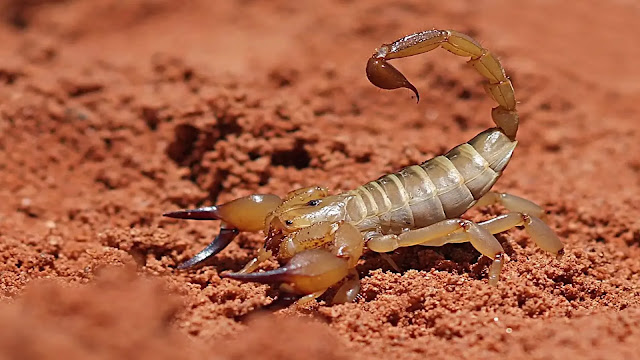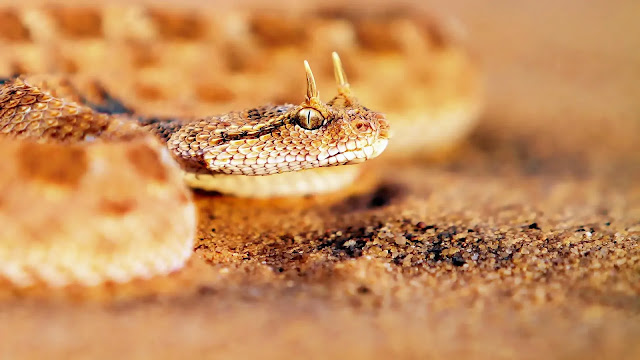When you hear the phrase "Sahara desert," images of intense heat, ferocious winds, sparse flora, and water are generally the first that come to mind. The Sahara desert is home to several creatures despite being one of the hardest ecosystems on earth. Here is a list of 10 Sahara Desert animal species that are incredibly adaptable.
1 - Deathstalker Scorpion
1 - Deathstalker Scorpion
The deathstalker scorpion is among the world's most venomous scorpions and one of the creatures that inhabit the Sahara desert; its venom is a severe neurotoxin. meaning that if it stings you only once, you could have headaches, vomiting, and even death if you don't seek medical attention right away. These scorpions are relatively yellowish or light green in appearance, and they can be found in the Sahara Desert. They are enjoyed by moths and prawns, in addition to other small, fat insects.
2 - Sidewinder Snake
The sidewinder snake is found in the Sahara Desert. In addition to the desert, it is also the most lethal snake in the world, which can kill any person. By the way, another name for this snake is "horn viper." In addition to being deadly, the sidewinder snake can run at a pace of 29 km/h. The sidewinder snake, like other sand monsters, is renowned for attacking while concealing itself beneath the sand; it only pokes its eyes out to keep a watch on its target. When a victim gets close to this snake,
3 - Dromedary Camel
A camel is the first image that springs to mind when one imagines a desert. The most common camel in the Sahara is the Dromedary, which is thought to have originated in Arabia. These camels are unique in that they can store fat in their humps rather than water. In just ten minutes, they can consume up to 100 liters of water. Due to their remarkable strength, endurance, and ability to survive for extended periods of time without food or water, they make excellent domesticated animals in the Sahara. Read This: 10 Camel Facts to Introduce You to This Animal
4 - Fennec Fox
The Vulpes zerda, a mammal that lives in the arid Sahara Desert, is known as the Fennec fox. In addition to vegetables, these omnivores also consume rodents and insects. The normal den of a fennec fox is constructed out of sand, usually in open spaces or locations protected by vegetation, with stable sand dunes being regarded as their optimum home. They have the capacity to go for extended periods of time without water. These are the smallest foxes, and their fur is occasionally sought after in hunting. When mating season arrives, male foxes are particularly aggressive and mark their territories with urine. Because of the use of their skin for medicine, these creatures are in danger of extinction. In captivity, the fennec Fox can live for up to 14 years.
5 - Addax Antelope
The addax antelope (Addax nasomaculatus), a severely endangered species, is rarely seen in the Sahara. The indiscriminate hunting of this species has wiped out significant populations. The species is indigenous to Niger, Chad, and Mauritania. It is known as the "white antelope" because of its white coat color and long, twisted horns. The addax antelopes are well suited to the harsh desert environment and can go for unlimited lengths of time without water. As a result, they can only be found in places that have yearly rainfall of less than 100 mm. They drink water from their meal and dew while feeding on grasses and the leaves of desert plants.
You Might Also Enjoy This.
6 - Ostrich
They were primarily found in West and Central African savannas and deserts. This huge bird has many traits that make it well-suited to survive in arid regions like the Sahara. Ostriches don't care about the Sahara's harsh heat or lack of water. The body of the ostrich absorbs moisture from the plants it consumes to meet its needs for water.
7 - Saharan Cheetah
The Sahara cheetah is one of the top predators that inhabit the Sahara Desert (Acinonyx jubatus hecki). Currently, this highly endangered species has only 250 mature adults left. They are mostly to be found in the central and western desert regions. These Cheetahs are lighter in color than some other African cheetahs, and their spots and tear stripes are less obvious. They consume gazelles and antelopes like addax. They occasionally chase hares as well. They typically lead a semi-nomadic existence and are solitary by nature. Typically, they hunt at night.
8 - Desert Monitor
The desert monitor is one of the huge lizards that dwell in deserts. They reside in the Western Sahara, the Arabian Desert, and arid regions of Central Asia. During the day, the desert monitors start to operate. Their skin is ideally suited for surviving in the desert climate. in order for desert monitors to endure the extreme heat of the Sahara. Salt glands on desert monitors also aid in preventing water loss. The desert monitors assault their prey suddenly. The major prey items of desert monitor lizards are small mammals, insects, and birds.
9 - Dorcas Gazelle
A small species of gazelle called the dorcas gazelle (Gazella dorcas) lives in the Sahara Desert and the nearby grasslands. The Dorcas gazelle has an excellent adaptation to desert life. It is capable of going its entire existence without drinking, yet when water is provided, it does. These gazelles are out hunting for desert vegetation's leaves, fruits, branches, and flowers from twilight until sunrise.
10 - African Wild Dog
The African wild dog (Lycaon pictus), an endangered species, is a native of sub-Saharan Africa. There are currently just 39 subpopulations totaling 6,600 adults left in this canid species. African wild dog numbers are declining as a result of infectious illness outbreaks, human persecution, and habitat destruction. These animals are extremely sociable and hunt and live in big packs. This species' females, not the males, depart the pack when they reach sexual maturity. Their main prey is antelope.










